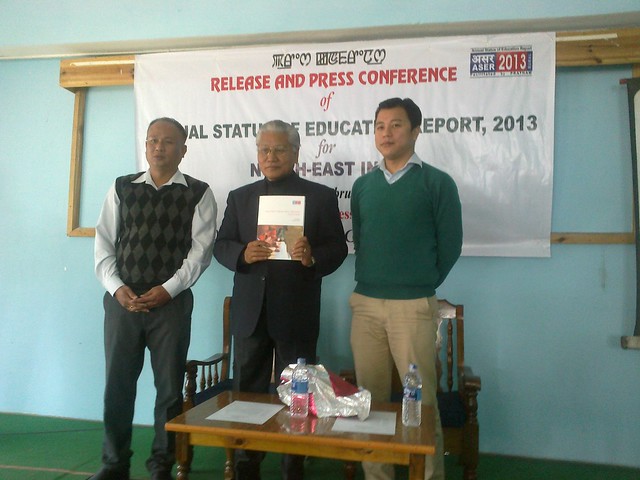By Dr. Syed Ahmed, for TwoCircles.net,
Imphal: The Annual Status of Education Report (ASER) 2013, the largest household survey of children in rural India, has shown that the enrolment of children in the age of 6-14 in the North East States is quite high compared to many of the States in mainland India. In Mizoram just 0.4% of the children in the age 6-14 are out of school. The percentage of out of school children is also quite low in Tripura (1.1%), Nagaland (1.2%), Sikkim (1.3%) and Manipur (1.5%). However, in Assam 3.8% of children are not in school. All-India average is 3.3%.
Except in Manipur and Meghalaya, the enrolment of children in the age 6-14 in private schools is not very high in NE States. Manipur (70.8%) has the highest private school enrolment in India. However, in Tripura just 6.7% of children are enrolled in private schools. In Assam 17% of the children are enrolled in private schools. The All-India average is 29%.

The percentage of children in the age 6-14 who receive paid tuition is very high in Tripura (65.8%). However, the proportion is quite low in other NE States. Just 3.7% of the children in Mizoram, 13.3% in Meghalaya, 16.7% in Nagaland take paid tuition. All-India average is 24%. West Bengal (73.9%) has the highest percentage of children taking paid tuition.
More than 70% of the children in Standard III-V in Sikkim, Nagaland, Mizoram, Meghalaya and Manipur could read Standard I level text or more. However, just 46.4% of the children in Standard III-V in Assam and 53.6% in Tripura could read Standard I level text or more. More than 60% of the children in Standard III-V in Manipur, Mizoram and Sikkim could do subtraction or more. However, the percentage is quite low in Assam (30%) and Tripura (41.6%).
Over 70% of the children in Standard VI-VIII in Manipur Meghalaya, Mizoram, Nagaland and Sikkim could read Standard III level text. More than 60% of the children in Standard VI-VIII in Manipur and Sikkim could do division. However, just 19% of the children in Assam, 28.2% in Tripura and 29.5% in Meghalaya could do division.
The ASER team visited selected schools in every State to see whether these schools comply with some of the norms and standards of RTE Act. The proportion of schools in NE States that comply with the norms of RTE Act continues to grow.
More than 90% of the schools visited in Manipur, Nagaland and Sikkim meet the RTE norms of pupil-teacher ratio. However, in Assam just 31.3% of the schools visited meet the norm.
Most of the schools visited in NE States did not have facility for drinking water. In Assam and Sikkim just 21% of the schools had the facility. In Manipur 80% of the schools visited had drinking water facility.
However, most of the NE States have toilet facility. Just 2.1% of the schools visited in Sikkim, 3.7% in Tripura and 8% in Mizoram and Nagaland did not have toilet facility. In Manipur 65.4% of the schools visited in Manipur and around 40% of the schools in Meghalaya and Nagaland did not have separate toilet for girls.
Most of the schools visited in NE States did not have library facility. More than 80% of the schools in Manipur and Mizoram did not have provision of libraries in schools.
Mid Day Meal (MDM) was observed being served on the day of the visit in more than 90% of the schools in Mizoram, Tripura and Sikkim. However, MDM was found served in just 28% of the schools in Nagaland and 40% in Manipur.
Except in Manipur (59%) and Tripura (62.2%), the actual attendance of enrolled children in schools is quite high. More than 70% of the enrolled children were found attending schools in Assam (74%), Meghalaya (72%), Mizoram (84.2%), Nagaland (84.4%) and Sikkim (87.6%).
Attendance of teachers was also found quite high in almost all the NE States. More than 80% of the teachers were found attending schools in Assam, Mizoram, Meghalaya, Nagaland, Tripura and Sikkim. However, in Manipur just 70% of the teachers were found in school.
The ASER 2013 – the ninth annual report – was released in New Delhi on January 15, 2014 by Montek Singh Ahluwalia, Deputy Chairman, Planning Commission.
The ASER 2013 for the States of NE India was released on February 19, 2014 by ASER Centre, Manipur at Manipur Press Club by Former Member of Steering Committee of NER Vision 2020 Prof. N. Mohendro Singh.
ASER, facilitated by Pratham, is the largest annual household survey of children in rural India that focuses on the status of schooling and basic learning. Every year, ASER finds out whether children in rural India go to school, whether they can read simple text and whether they can do basic arithmetic. In 2005, 2007, and every year since 2009, ASER has also included a visit to one government school in each sampled village. Since the implementation of the RTE Act in 2010, school visits in ASER have included indicators of compliance with those norms and standards specified in the RTE Act that are easy to measure. In 2013, ASER visited 14,724 government schools.
ASER 2013 reached 550 districts and close to 16,000 villages, 3.3 lakh households and 6 lakh children in the age group 3-16.

